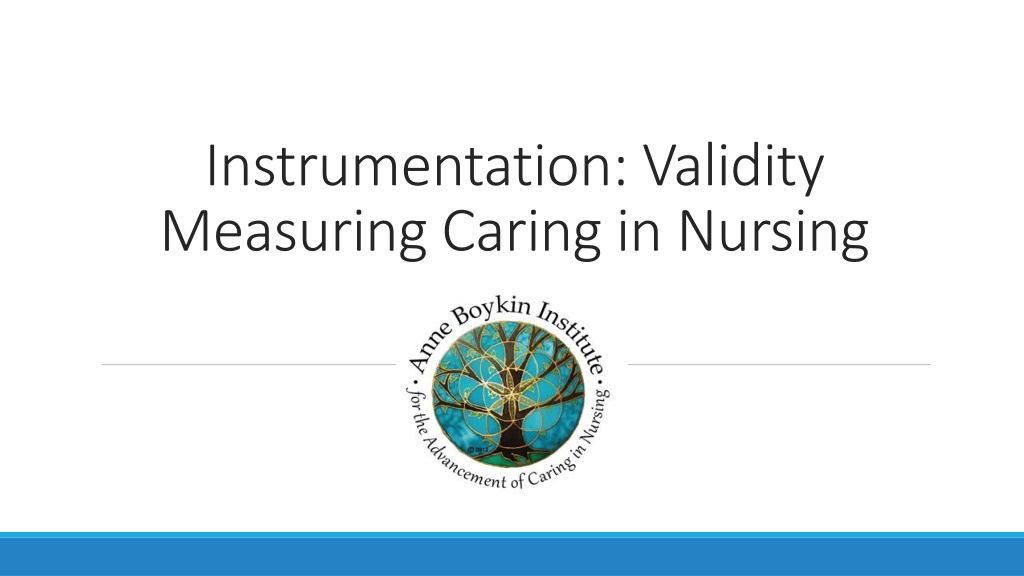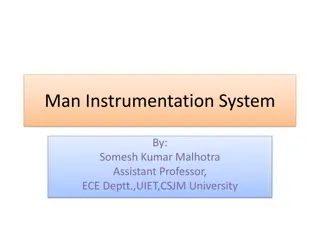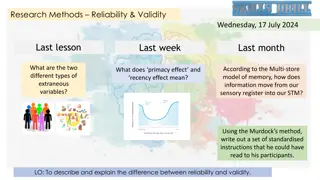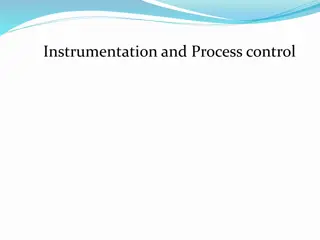Understanding Validity in Nursing Instrumentation
Validity in nursing instrumentation is crucial for measuring caring effectively. It involves ensuring that the instrument reflects the abstract construct being examined and measures what it is supposed to measure. Face validity, content validity, and theoretical validity play essential roles in establishing the credibility of measurement tools in nursing. The interplay between technology and caring is also explored in instruments like the Technological Competency as Caring in Nursing Instrument (TCCNI). Through careful construct analysis, literature review, and item development, valid and reliable measures of caring behaviors can be created to enhance nursing practice.
Download Presentation

Please find below an Image/Link to download the presentation.
The content on the website is provided AS IS for your information and personal use only. It may not be sold, licensed, or shared on other websites without obtaining consent from the author. Download presentation by click this link. If you encounter any issues during the download, it is possible that the publisher has removed the file from their server.
E N D
Presentation Transcript
Instrumentation: Validity Measuring Caring in Nursing
Validity: Defined Extent to which instrument reflects abstract construct being examined; measures what it is supposed to measure Domain or Universe of Construct Concept analysis Extensive literature search; theory Qualitative study results Conceptually define the construct and subconcepts Blueprint or matrix Test items Instrument items
Validity: Face Face Validity: Instrument looks like it is measuring the construct Face and content validity of the CARE-Q were established by carefully identifying and developing the behavioral items from the perspective of both nurse and patient in two earlier studies conducted by Larson
Validity: Content Types Content validity: extent to which method of measurement includes appropriate sample of items for construct being measured and adequately covers construct; based on subjective judgment; how representative are the items of the universe of items on the topic? evidence comes from literature theory representatives of relevant populations content experts
Validity: Content, Theoretical Content Validity: Theoretical validity domain of construct identified through concept analysis or extensive literature search; qualitative methods can also be used matrix or blueprint is created to develop items for a test item format, item content, and procedures for generating items carefully described
Validity: Content, Theoretical Technological Competency as Caring in Nursing Instrument (TCCNI): Locsin explicated theoretical underpinnings of nursing grounded in caring and technology. TCCNI advances the interrelationship between technology and caring in nursing, emphasizing professional nurse caring competence through technological knowing Caring Nurse Observational Tool (CNOT) is framed in Watson s(1997) humanistic stance (10 carative factors under 3 dimensions) and Watzlawick et al. s (1967) interactive communication (2 axes of communications) with content and relational elements. The Humanistic Aspect of care, Therapeutic relationship, and Clinical Activities are main parts of the frame of reference Individual CARE-Q behavioral items are derived from a preliminary study with patients and provide theoretical categorizations of the behavioral items
Validity: Content, Theoretical Caring Behaviors Assessment (CBA): based on Watson s description of caring, reflecting existential-phenomenological and spiritual influence in Watson s value system and helped form Watson s Carative Factors; carative factors were used as a framework for development of the CBA Using results from a literature review, 48 indicators of caring were selected and classified as being either content or relational and verbal or non-verbal behaviors in the Caring Nurse Observational Tool (CNOT)
Validity: Content, Expert Content Validity: Expert validity experts (5 or more) judge items in relation to fit with construct and subscales of construct experts rank items on scale and record comments experts use scale 1 = not relevant; 2 = unable to assess relevance without item revision or item in need of such revision that it would no longer be relevant; 3 = relevant but needs minor alteration; 4 = very relevant and succinct means calculated and decisions made about items (Lynn, 1986; Thomas, 1992) comments include offering critique of items, etc., including readability and language used
Validity: Content, Expert Content Validity Index (CVI) Numerical value reflecting level of content-related validity Experts rate content relevance of each item using 4-point rating scale Items rated according to 4-point Lynn scale Complete agreement among expert reviewers to retain an item with 7 or fewer reviewers Relevance = 4 on 4 pt. scale 4 of 6 reviewers rate item relevant; 4/6 or 0.67%
Validity: Content, Expert Type Content validity was established by a panel of four nurse experts (CBI-42) Lynn s Content Validity Index (CVI) approach was used to establish the Technological Competency as Caring In Nursing Instrument (TCCNI); theory and practice experts (N = 13) assessed content validity of 30 items. The final instrument with 25 items had a Scale-Content Validity Index/Universal Agreement of .72 Item and scale level content validity was established at .92 to 1.00 based on five expert reviewers on the Adapted Caring Behavior Checklist
Content Validity, Expert: Example CBI-E items originated in related literature and research on nurse caring from patients and nurses perspectives as well as expert review. Six experts in gerontologic nursing reviewed the CBI-E and rated the items, directions, length, and other critical points regarding this draft so that content validity of the expert type (Burns & Grove, 2005) was established. Three of the experts were doctoral-prepared. Two were geriatric nurse practitioners, three were clinical nurse specialists, one was a long-term care administrator, and one was a psychiatric-mental health clinician. The content validity (content relevance) of each item was rated by experts using the following 4-point rating scale (Lynn, 1986): 1 = not relevant; 2 = unable to assess relevance without item revision or item is in need of such revision that it would no longer be relevant; 3 = relevant but needs minor alteration; 4 = very relevant and succinct (p. 384). Items were revised based on expert reviews and one item was eliminated from the 29-item draft. This item had the lowest mean. Experts commented on nebulous wording on specific items and on the excellence of many. Specific item revisions were offered and the investigators modified several items accordingly.
Content-Related Validity: Example The content validity of the Nurse-Nursing Assistant-Caregiver Reciprocity Scale (NNA-CRS) was examined through extensive literature review, focus group member checking of item wording and themes, and calculation of the content validity index (CVI) from content experts (3 experts, CVI = .90)
Construct Validity Construct Validity: test assumptions about instrument; extent to which test measures theoretical construct
Construct Validity: Hypothesis-testing Theory or concept underlying instrument s design used to develop hypotheses regarding behavior of individuals with varying scores on the measure; determine if rationale underlying instrument s construction is adequate to explain findings
Construct Validity: Known Groups Hypotheses identified about expected response of known groups Contrasted or known groups: groups who may have significantly varied scores on instrument t-test or ANOVA determines difference Male and female participants perceptions of nurse caring compared on the CBI-42; no statistically significant difference found (t = -.682, df = 67, p = 0.49) Patient and nurse perceptions of nurse caring differed on the CBI-42 (t = 3.01, df = 539, p = .003) African American, White, and Hispanic Perceptions of Caring on the Caring Behaviors Inventory for Elders (CBI-E) were compared; no statistically significant difference found (F = .252, df = 2, 169, p = .778)
Construct Validity: Multitrait-multimethod (Discriminant and Convergent) Multiple measures of perceptions of nurse caring Caring Dimension Inventory scores correlated with a 1-item Caring Behavior measure, scaled with ordinal data (Convergent) Interviewing patients about nurses caring behaviors and observing nurses caring behaviors using a checklist (CNOT) Visual Analog Scale to measure nurse caring behavior according to patients correlated in same study with Caring Dimension Inventory scores (Convergent)
Construct Validity: Discriminant (Divergent) Construct Validity: Discriminant validity Instrument that measures opposite of construct is administered to subjects at same time the instrument measuring variable in research question is; results are compared with correlation coefficient (r = - 0.??) Caring Behavior (CB) (CBI-24) was correlated with Burnout (BO). The correlation coefficient was 0.333 (p = .01). Emotional intelligence and psychological ownership help reduce the burnout of nurses by decreasing their feelings of depersonalization; this effect in turn improves the caring behavior of nurses. The hypothesized negative relationship between BO and CB was not supported.
Construct Validity: Convergent Construct Validity: Convergent validity two or more tools that measure the same construct are administered at same time to same subjects; demonstrated by high correlations between scores (r = + 0.??) Construct validity of the convergent type was tested using the CBI-E and Cronin and Harrison s Caring Behaviors Assessment (CBA), a 62-item instrument (Baldursdottir & Johsdottir, 2002; Cronin & Harrison, 1988) with authors' (Cronin & Harrison) permission. Fourteen senior citizens residing in an independent- residing residence participated. A moderately strong, non statistically significant correlation (r = .50, p = .06) was calculated between the total scores of the CBI-E and CBA.. There was a significant, positive, moderate correlation between the caring scores (Modified Caring Dimensions Inventory [CDI-29]) and empathy (Toronto Empathy Questionnaire) scores (r = 0.5, p = 0.001)
Construct Validity: Expanded Example Construct validity of the convergent type (Waltz, Strickland, & Lenz, 1984) was tested using the CBI-E and Cronin and Harrison s Caring Behaviors Assessment, an 62-item instrument (Baldursdottir & Jonsdottir, 2002; Cronin & Harrison, 1988) with the authors (Cronin & Harrison) permission. Fourteen senior citizens residing in an independent residence participated. There was a moderately strong, non statistically significant correlation (r = .50, p = .06) calculated between the total scores of the CBI-E and the CBA. The null hypothesis could be false. However, the sample size is too small; additional testing is necessary to confirm convergent validity.
Validity: Factor Analysis relationships among various items of instrument established; items fall into a factor, correlate with other items items that are closely related are clustered into a factor factor = subscale = dimension = domain instrument may reflect several constructs rather than one construct factor loadings (-1 to +1) may be thought of as correlations of the item with the factor
Construct Validity: Convergent Every year approximately 4 million women in the United States experience childbirth. This event has been cited as pivotal in a woman's life. Labor support is an important part of this experience since it influences the woman's classification of the birth experience as positive or negative. Therefore, understanding how intrapartum nurses perceive the role of supportive care during labor is paramount. The purpose of this study was to develop a reliable and valid instrument that measures intrapartum nurses' perceptions concerning the importance of professional labor support in their practice. The sample included 146 intrapartum nurses from Texas. Cronbach's alpha, Pearson's r, and descriptive statistics were used for data analysis. Cronbach's alpha for the Labor Support Questionnaire (LSQ) was 0.90. Convergent validity with the Caring Behavior Inventory was .57 (p < .001). Findings indicated beginning support for the reliability and validity of the LSQ. Further development and psychometric testing is recommended to ascertain the dimensionality of the LSQ.
Validity: Factor Analysis or Factorial number of constructs in instrument can be validated through use of confirmatory factor analysis; one-dimension instrument (Principal Component Analysis) factor loadings are proportion of variance the item and factor have together communality is portion of item variance accounted for by various factors eigenvalue for factor is total amount of variance explained by factor (add squared loadings contained in single column [factor]) factor eigenvalues and variance accounted for are most important results in unrotated factor matrix
Criterion-Related Validity: Predictive, Future and Concurrent Predictive Validity: Future events Scores on one instrument predicts future scores on a second instrument Predictive Validity: Concurrent events Scores on one instrument predicts score on a second instrument
Criterion-Related Validity: Predictive Validity Test scores are related to a criterion Criterion is behavior that test scores are used to predict Correlation coefficient X is test score and Y is criterion score predictive or concurrent validity estimate is established by a validity coefficient (correlation coefficient)
Criterion-Related Validity: Predictive Predictive-validity = future test score (X) now, correlate with future criterion score (Y) Concurrent-validity = at same time test score (X) now, correlate with same time criterion score (Y) now The Nurse-Nursing Assistant-Caregiver Reciprocity Scale (NNA-CRS) correlated with Kouvonen et al. (2006) Social Capital Scale (r = .546, p = <.05)
References Cossette & Forbes (2012) Dunnington & Farmer (2015) Kaur, Sambasivan, & Kumar (2013) Kouvonen et al. (2006) Parcells & Locsin (2011) Wolf et al. (1994) Yen-Patton, Dowling, & Clayton-Matthew (2013)























